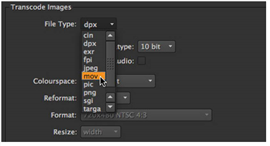
Transcoding in Nuke Studio uses a background render process to convert one file format to another. You can transcode sequences, timeline selections, and clips from the bin view.
| 1. | Select a sequence in the bin view and navigate to File > Export... |
The Export dialog displays.
| 2. | Select Process as Sequence and the preset you intend to use, or the default dpx preset. |
| 3. | Enter the Export To directory or click Choose... and browse to the location. |
| 4. | Edit the shot template as necessary to control the export file structure. |
| 5. | Click the Content column to select a format to transcode to using the File Type dropdown. |

The controls exposed depend on the transcode you’re applying.
| 6. | Complete the File Type specific controls. For example, selecting dpx exposes the datatype, transfer, Big Endian, and Fill settings. |
| 7. | Complete the general controls common to all file types: |
• Include Audio - when enabled, any audio tracks are exported alongside the video.
• Colorspace - use the dropdown to set the colorspace to render, such as linear, REDLog, or raw.
• Reformat - select the required reformatting option to enable the Format dropdown.
• Format - sets the format to render out in Nuke, such as 1920x1080 HD 1080.
TIP: Select Custom... to create formats that don’t appear in the list of presets.
• Resize - sets the method by which you want to preserve or override the original aspect ratio:
• width - scales the original until its width matches the format’s width. Height is then scaled in such a manner as to preserve the original aspect ratio.
• height - scales the original until its height matches the format’s height. Width is then scaled in such a manner as to preserve the original aspect ratio.
• fit - scales the original until its smallest side matches the format’s smallest side. The original’s longer side is then scaled in such a manner as to preserve original aspect ratio.
• fill - scales the original until its longest side matches the format’s longest side. The input’s shorter side is then scaled in such a manner as to preserve original aspect ratio.
• distort - scales the original until all its sides match the lengths specified by the format. This option does not preserve the original aspect ratio, so distortions may occur.
| 8. | Select the Channels to export from the dropdown. If you want to export a non-standard channel, type the name of the channel into the field manually. |
| 9. | Select the Retime Method to apply, if applicable. |
| 10. | Check Keep Nuke Script if you require the .nk files after the transcode operation. |
| 11. | Enable the Burn-in Gizmo to burn-in text using a Nuke gizmo. Click Edit to define the information applied during burn-in. See Adding Burn-in Text to Exports for more information. |
| 12. | Specify any Additional Nodes required during export by clicking Edit. SeeAdding Additional Nodes During Export for more information. |
| 1. | Click the Tracks and Range tab and select the Tracks For This Export by enabling or disabling the tracks in the list. Nuke Studio exports all tracks by default. |
| 2. | Enable or disable tags using the Filter by Tag panel. Click the checkbox to cycle through the available tag states. |
| 3. | If you set in and out point on the sequence, enable In/Out Points to export only the selected frames. |
| 4. | Set how clip Start Frames are derived using the dropdown menu: |
• Sequence - use the sequence’s start frame.
• Custom - specify a start frame for all clips using the field to the right.
| 5. | Set the Version number for the export, if applicable. Use the arrows to increment the version number and the +/- buttons to increase or decrease the padding. You can also type directly into the numeric field. |
NOTE: See Using Versions for more information on how versioning works in Nuke Studio.
| 6. | Set how Nuke Studio should render your export using the Render with dropdown. The following options are available: |
• Frame Server - uses multiple Nuke processes to speed up render times and shares a render queue with any Nuke Comp renders in the timeline, improving resource management.
See Using Nuke Studio's Frame Server for more information.
• Single Render Process - uses a single Nuke process to render your export. Rendering QuickTimes falls back to this setting, but it's also used when a problem is detected with the Frame Server.
• Custom Render Process - uses a custom render process. Nuke Studio requires a Python script to pass exports to your render farm of choice. Scripts must be located in specific directories, dependent on platform, as listed in
| 7. | Click Export. |
The Export Queue window displays an estimate of how long each component of the export is expected to take.
Once the export is complete, the file structure specified in the shot template is created containing the transcoded files.
TIP: Click the magnifying glass icon to reveal the exported file in a browser window.
|
|